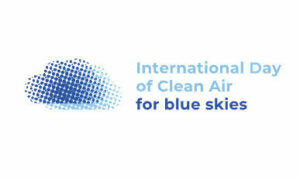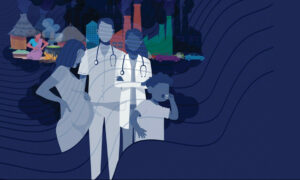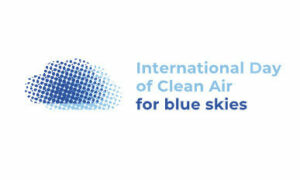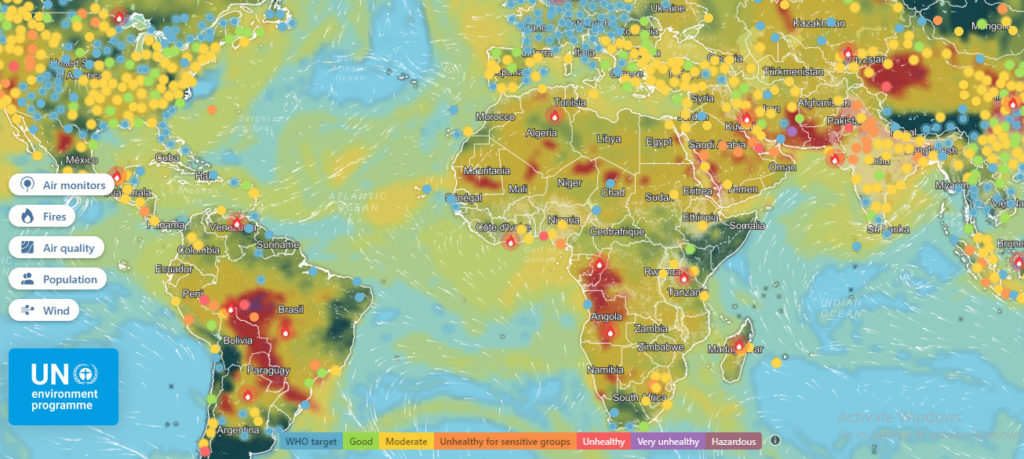Update
International Day of Clean Air for Blue Skies

Last updated: 21 Feb 2024
Encouraged by the increasing interest of the international community in clean air, and emphasizing the need to make further efforts to improve air quality, including reducing air pollution, to protect human health, the General Assembly decided in 2020 to designate 7 September as the International Day of Clean Air for blue skies.
International Day of Clean Air for Blue Skies
Clean air is important for the health and day-to-day lives of people, while air pollution is the single greatest environmental risk to human health and one of the main avoidable causes of death and disease globally. According to the United Nations Environment Programme (UNEP), air pollution is the world’s biggest environmental killer. Data from the World Health Organization (WHO) indicates that air pollution is responsible for around seven million premature deaths each year through diseases such as lung cancer, acute respiratory infections and heart disease, and that 9 out of 10 people breathe air containing high levels of pollutants. In addition, air pollution disproportionately affects women, children and older persons.
Air pollution doesn’t only affect human health, it also negatively impacts the climate, economic growth and our natural environment. Air pollution decreases the oxygen supply in our oceans, making it harder for plants to grow and as such, contributes to climate change. The good news is that air pollution is largely avoidable and its negative consequences are preventable. Solutions are known and can be implemented. The world needs to act now.
In order to raise awareness and mobilize efforts against air pollution, the international community celebrates each year International Day of Clean Air for Blue Skies, as set out in the UN General Assembly resolution 74/212.
Yearly Themes and Activities
Since 2020, the international community has been celebrating International Day of Clean Air for Blue Skies with a different theme selected for each year. Find more information for each year below:
- 2023 | Together for Clean Air
- 2022 | The Air We Share
- 2021 | Healthy Air, Healthy Planet
- 2020 | Clean Air for All
International Day of Clean Air for Blue Skies 2023
The theme of the fourth International Day of Clean Air for Blue Skies is “Together Clean Air”, focusing on the need for stronger partnerships, increased investment and shared responsibility to overcome air pollution. Given the transboundary nature of air pollution, all stakeholders have a responsibility to protect the earth’s atmosphere and ensure healthy air for everyone. Working together, across borders and boundaries, between sectors and beyond silos, will help reduce air pollution, leverage finance and investments toward air quality measures and solutions, and provide many benefits. This International Day of Clean Air for blue skies, everyone, from governments and corporations to civil society and individuals is called upon to come together to overcome air pollution.
Events

Webinar: New opportunities for air pollution and health education – launching an OpenWHO online course for health workers
5 September 2023 | 13:00 – 14:15 | WHO

International Day of Clean Air for Blue Skies: Together for Clean Air
6 September 2023 | 08:30 – 09:45| Palais des Nations, Room III |UNECE Convention on Long-Range Transboundary Air Pollution, United Nations Environment Programme
Clean Air and the Sustainable Development Goals
The right to breathe clean air goes hand in hand with achieving the Sustainable Development Goals, including healthy lives, sustainable cities, access to clean energy, and climate change mitigation. In “The Future We Want” of the United Nations Conference on Sustainable Development, countries committed to promoting sustainable development policies that support healthy air quality in the context of sustainable cities and human settlements. In addition, the 2030 Agenda for Sustainable Development outlines a road map to achieving sustainable development, environmental protection and prosperity for all, recognizing that air pollution abatement is important to the attainment of the Sustainable Development Goals. Air pollution is directly mentioned in two SDG targets:
- Target 3.9: By 2030, substantially reduce the number of deaths and illnesses from hazardous chemicals and air, water and soil pollution and contamination
- Target 11.6: By 2030, reduce the adverse per capita environmental impact of cities, including by paying special attention to air quality and municipal and other waste management

Clean Air is a Human Right
Poor air quality has implications for a wide range of human rights, including the rights to life, health, water, food, housing and an adequate standard of living. Air pollution also clearly violates the right to a healthy and sustainable environment.
Air pollution is a preventable problem. The solutions − laws, standards, policies, programmes, investments and technologies − are known. Implementing these solutions will of course entail large investments, but the benefits of fulfilling the right to breathe clean air for all of humanity are incalculable.
In “The Right to Breathe Clean Air” report to the General Assembly by David R. Boyd, UN Special Rapporteur on Human Rights and the Environment, offers a number of recommendations to States for actions they should consider as part of a national air quality action plan. The Special Rapporteur also urges businesses to fulfill their responsibility, to contribute to and support efforts to reduce air pollution.
Air Pollution and Climate Change
The main sources of air pollution and greenhouse gases are often the same. Most actions to improve air quality also therefore help to fight climate change. Many of the drivers of climate change such as inefficient and polluting forms of energy and transport systems contribute to air pollution. Thus, strategies to fight both climate change and air pollution go hand in hand.
Burning of fossil fuels – for power, transportation, and industry – is the main source of the carbon emissions driving climate change and a major contributor to health-damaging air pollution. Scientists anticipate that a warming climate will worsen air quality. If current emissions continue, ground-level ozone events are expected to intensify, especially in densely populated areas, leading to more respiratory illness.
In certain areas, the frequency and extent of wildfires – and with them, emissions of PM and other pollutants – are projected to increase. In some areas, a drier climate will lead to more dust storms; in others, pollen and other airborne allergens are likely to increase. As the globe warms, wildfires and associated air pollution are expected to increase, even under a low emissions scenario.
The United Nations Intergovernmental Panel on Climate Change (IPCC) in its Sixth Assessment Report (AR6) includes scenarios on how air quality may evolve as the climate warms throughout the twenty‑first century. These scenarios range from the possibility of increased emissions of air pollutants in developing regions of the world, to a carbon‑neutral scenario in which urgent and effective policies to limit emissions of greenhouse gases (such as CO2 and methane) provide the co‑benefit of rapidly reducing emissions of air pollutants (such as NO, black carbon or sulfur dioxide – SO2).
Plastics and Air Pollution
While we are familiar with the presence and impact of plastic on oceans and the freshwater ecosystem, the plastic crisis is multifaceted and deeply connected to other aspects of the ongoing environmental crisis. In fact, the plastics sector is one important industrial contributors to air pollution. Microplastics have been detected in the atmosphere of urban, suburban, and even in remote areas such as in high-altitude glaciers, the Arctic and Antarctic suggesting potential long-distance atmospheric transport for microplastics. The incineration of plastic waste also releases toxic gases such as dioxins, furans, mercury and polychlorinated biphenyls into the atmosphere and poses a threat to the environment.
Monitoring Air Quality
Globally
In 2021, UNEP published the First Global Assessment of Air Pollution Legislation (GAAPL) and presented the findings of a study of air quality legislation in 194 countries and the European Union. Using the Air Quality Guidelines developed by the WHO as a starting point, the report examines the legal measures for determining whether air quality standards are being met and what legal standards exist for failure to meet them. UNEP also published The European and Central Asian Actions on Air Quality report. In September 2023, the WHO published an Overview of methods to assess population exposure to ambient air pollution, summarizing several air quality measurement and modelling methods that can be used to estimate ground-level air pollutant concentrations and presents multiple approaches to monitoring ambient air pollution at different spatial and temporal scales.
Click on the image below to explore the quality of air worldwide in real time.
In Geneva
The air quality in Geneva is constantly under observation and four fixed measuring stations are active in the canton. Geneva is implementing measures targeting the sources of the pollution and applying a cantonal strategy to prevent air pollution.
- La qualité de l’air en 2022 | Swiss Federal Office for the Environment (FOEN) | 16 October 2023
- Qualité de l’air en 2022 à Genève: tendance favorable au-delà des effets dus à la pandémie | 4 July 2023
- Current air quality in Geneva
- Air quality in the last 10 days
- Air quality in recent years
- Air2G² : air quality in Great Geneva region
- Stick’AIR sticker
- Blogs Air-Genève
- Spatial distribution of nitrogen dioxide
The Role of Geneva
Addressing air pollution requires multisectoral and multistakeholder efforts that build upon synergies between different organizations. As a global hub for international environmental governance, air pollution is a priority for Geneva and the various intergovernmental, international and non-governmental institutions active in the area (listed below in alphabetical order). The First WHO Global Conference on Air Pollution and Health took place in Geneva in from 30 October to 1 November 2018.
The Global Alliance on Health and Pollution (GAHP)
GAHP is a collaborative body of more than 60 members and dozens of observers that advocate for resources and solutions to pollution problems. Focusing on improving health as a priority and key metric for combatting pollution, GAHP recognizes that collaborative, multi-stakeholder, multi-sectoral approach is necessary and critical to deal with the global pollution crisis and resulting health and economic impacts, as seen in their report, “Air Pollution Interventions: Seeking the Intersection Between Climate and Health“.
International Organization for Standardization (ISO)
ISO is a global network of the world’s leading standardizers. ISO has many international standards that contribute to cleaner air and reducing pollution. ISO’s technical committee ISO/TC 146, Air quality2) , has over 170 published standards and 37 in development that cover a range of areas such as the measurement of air pollutants and emissions, workspace air and indoor air.
Stockholm Convention
The Stockholm Convention on Persistent Organic Pollutants is a global treaty to protect human health and the environment from chemicals that remain intact in the environment for long periods, become widely distributed geographically, accumulate in the fatty tissue of humans and wildlife, and have harmful impacts on human health or on the environment. Exposure to Persistent Organic Pollutants (POPs) can lead to serious health effects including certain cancers, birth defects, dysfunctional immune and reproductive systems, greater susceptibility to disease and damages to the central and peripheral nervous systems. Given their long range transport, no one government acting alone can protect its citizens or its environment from POPs.
United Nations Economic Commission for Europe (UNECE)
To improve air quality, UNECE member states have been working successfully to reduce air pollution in the region through the Convention on Long-Range Transboundary Air Pollution. Eight protocols identify specific measures to be taken by the Parties to cut their emissions. The Convention also provides access to emission, measurement and modelling data and information on the effects of air pollution on ecosystems, health, crops and materials.
United Nations Special Rapporteur on Human Rights and the Environment
The Special Rapporteur on Human Rights and the Environment is mandated to continue to study the human rights obligations relating to the enjoyment of a safe, clean, healthy and sustainable environment. The current Special Rapporteur, David R. Boyd, developed “The Right to Breathe Clean Air” report for the UN General Assembly with a number of recommendations to States for actions they should consider as part of a national air quality action plan. He also urges businesses to fulfill their responsibility, to contribute to and support efforts to reduce air pollution.
World Economic Forum (WEF)
The Alliance for Clean Air works towards a 1.5° trajectory by 2030 by catalyzing action on ambient air pollution and prioritizing health. WEF also provides strategic insights and contextual intelligence on air pollution.
World Health Organization (WHO)
The First WHO Global Conference on Air Pollution and Health took place in Geneva in from 30 October to 1 November 2018. The WHO also developed the guideline “Health and the Environment: Addressing the Health Impact of Air Pollution“.
World Meteorological Organization (WMO)
The Global Atmosphere Watch Programme of the WMO studies the variability and trends in atmospheric composition and related physical parameters, and assesses their consequences. One major aspect of the Global Atmosphere Watch is to organize, participate in and coordinate assessments of the chemical composition of the atmosphere on a global scale. In this way, the Global Atmosphere Watch provides reliable scientific information for national and international policymakers, supports international conventions on stratospheric ozone depletions and monitors climate change and long-range transboundary air pollution.
The WMO publishes the Air Quality and Climate Bulletin, reporting annually on the state of air quality and its connections to climate change, reflecting on the geographical distribution of and changes in the levels of traditional pollutants. The Bulletin highlights the main factors that influence air quality patterns, in comparison to other years, showing how there were episodes of both improvement and deterioration of air quality in different parts of the world.
Global Campaigns
Alliance for Clean Air
The World Economic Forum has partnered with UNEP to engage the private sector and garner commitments through the Alliance for Clean Air. It brings together different sectors and organization to share facts, best practices, work through the barriers to action, and develop public-private partnerships.
BreatheLife
BreatheLife is a global campaign launched in 2016 to mobilize cities and individuals to protect our health and planet from the effects of air pollution. It combines public health and climate change expertise with guidance on implementing solutions to air pollution in support of global development goals. The campaign is supported by WHO, UNEP, the World Bank and the Climate and Clean Air Coalition. BreatheLife’s growing network includes 76 cities, regions, and countries.
Clear the Air
As the population approaches 10 billion with people concentrated in urban areas, air pollution is likely to worsen. Clearing the air has garnered governmental commitment. On 1 September 2020, UNEP launched Clear the Air as part of its #BeatPollution campaign and aims to raise awareness about the impact of air pollution.
Learning

Air Pollution Quiz
Clean air for blue skies
Resources
- Official Website of the Day
- International Day of Clean Air for blue skies | United Nations
- UN General Assembly resolution 74/212 | UN | 22 January 2020
- Clean Air Day Guide | UNEP
- Climate and Clean Air Coalition
- Air Pollution | WHO
- Clean Air | UNECE
- Global Atmosphere Watch Programme | WMO
- Clean Air and Human Rights | UN Special Rapporteur on Human Rights and the Environment
- Air pollution and Multilateral Environmental Agreements | InforMEA
- Alliance for Clean Air | WEF
- Air Pollution | Strategic insights and contextual intelligence | World Economic Forum
- Global Coalition on Health, Environment and Climate Change (HECC) | WHO-UNEP-WMO
- Pollution Action Note – Data you need to know | UNEP
- Air | Swiss Federal Office for the Environment
- Air Quality in Geneva (LIVE) | Canton of Geneva
- Macaron Stick’AIR | Canton of Geneva
- Sustainably Improving Air Quality in Geneva | Canton of Geneva
- Electromobilité for Better Air Quality | Canton of Geneva
- PACT’Air Regional Collaboration | Canton of Geneva
- COVID-19 and Air Quality in Geneva | Canton of Geneva
News
- Finding super solutions to super pollutants | UNEP | 21 February 2024
- La première directive cantonale pour une meilleure qualité de l’air lors de chantiers | Département du territoire (DT) du Canton de Genève | 12 February 2024
- WMO Bulletin: heatwaves worsen air quality and pollution | WMO | 4 September 2023
- Clean air + green planet = good health for all | WHO Press Release | 5 July 2023
- Collaboration key to securing clean air for all, experts say | UNEP | 19 June 2023
- Slow Transition to Clean Energy Puts Billions at Risk of Household Air Pollution | Health Policy Watch | 6 June 2023
- Available air pollution reduction measures far cheaper than costs of damage to health, ecosystems and economy, confirms UN report | UNECE | 14 December 2022
- Does air pollution reduce cognitive function over time? | Liji Thomas | News-Medical.net | 4 December 2022
- Estimation of stillbirths attributable to ambient fine particles in 137 countries | Xue, T., Tong, M., Li, J. et al. | Nature Communications | 29 November 2022
- WMO Air Quality and Climate Bulletin highlights impact of wildfires | WMO | 7 September 2022
- Statement by Chief Scientists for the 2022 International Day of Clean Air for blue skies | IUCN, UNEP, WHO, WMO | 7 September 2022
- After landmark UN declaration, hope for cleaner air | UNEP | 24 August 2022
- International Day of Clean Air for blue skies highlights links between human and planetary health | UNEP | 7 September 2021
- The Gap Between Air Pollution Pacesetters and Laggards in Europe and Central Asia Has Widened, New Report Finds | UNEP | 3 September 2021
- 1 in 3 countries Have No Outdoor Air Quality Requirements: UN Report | The Hill | 2 September 2021
- Less Air pollution and More Access to Green or Blue Spaces: A Recipe to Improve the Life Quality of People with COPD | Science Daily | 2 September 2021
- Long-Term Exposure to Low Levels of Air Pollution May Be Linked to Higher Mortality | News Medical | 2 September 2021
- Air Pollution Linked to More Severe Mental Illness – Study | The Guardian | 27 August 2021
- These Five Cities Are Taking Aim at Air Pollution | UNEP | 27 August 2021
- Climate Change: Global Greenhouse Gas Levels Were Highest Ever in 2020 Despite Lockdowns, Study Finds | SkyNews | 26 August 2021
- Our Trash is Trashing the Planet’s Air Quality | UNEP | 12 August 2021
- UN Investigates How to Hit the Brakes on Traffic Pollution | Geneva Solutions | 14 January 2021
- Cooperation for Clean Air Must Be at the Heart of a Green Recovery from the COVID-19 Crisis | UNECE | 26 August 2020
- Blue skies ahead? Why cooperation between science and policy is the key to reducing air pollution | Pip Cook | Geneva Solutions | 14 September 2020
- Build a better future with blue skies for all, UN urges, marking first International Day of Clean Air | UN News | 7 September 2020
- Clean Air for all: towards a global community of action | Geneva Solutions | 7 September 2020
- The Big Interview: Dr Maria Neira, World Health Organization | Air Quality News | 7 May 2020
- Beat Air Pollution High-Level Dialogue, World Environment Day 2019 | Geneva Environment Network | 3 June 2019
- With a premature death every five seconds, air pollution is violation of human rights, says UN expert | UN News | 3 June 2019
- The Right to Breathe Clean Air | David R. Boyd, UN Special Rapporteur on human rights and the environment | 2019
- First WHO Global Conference on Air Pollution and Health | WHO | 30 October – 1 November 2018
- Climate Change and Air Pollution: Two Sides of the Same Coin | WHO | 2018
- The Paris Agreement is a Health Agreement – WHO | UNFCCC | 3 May 2018


